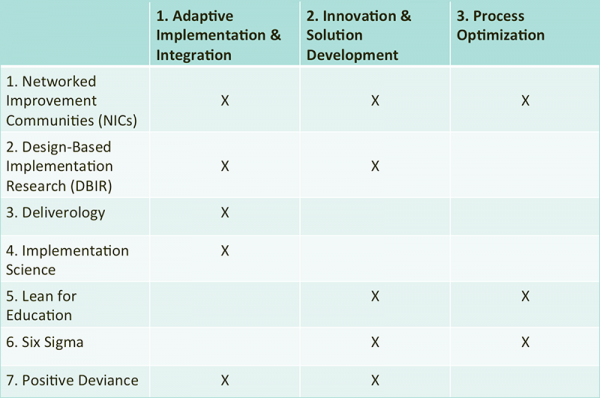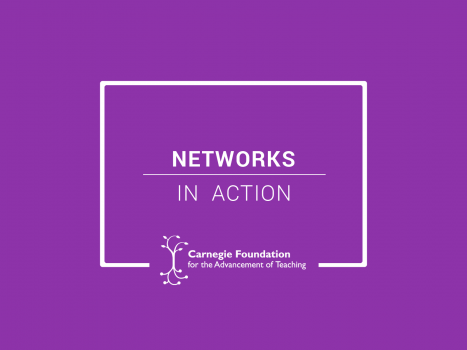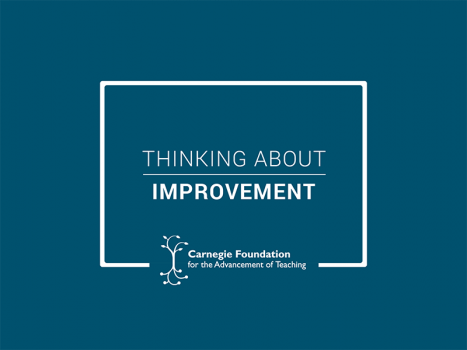Editor’s note: The current issue of Quality Assurance in Education is a special one, devoted entirely to exploring seven different improvement-based approaches to change being used in schools. Over several weeks, the Carnegie Foundation will publish blog posts summarizing each of the models, including the process, examples, and pros and cons. “Networked improvement communities: The discipline of improvement science meets the power of networks,” is authored by Paul G. LeMahieu and Alicia Grunow of the Carnegie Foundation, with Lee E. Nordstrum of RTI International, Laura Baker of The New Teacher Center, and Louis M. Gomez of the University of California, Los Angeles. We hope that these summary blog posts will whet your appetite to delve more deeply into the journal itself.
The series begins with the networked improvement model, a relatively new framework developed by the Carnegie Foundation when Anthony S. Bryk began his tenure as president in 2008, grounded in a rich history spanning decades of research and practice. It is adapted in great part from the Model for Improvement, created in the 1990s by Associates in Process Improvement (API). The API model, in turn, is based on W. Edwards Deming’s Plan-Do-Study-Act cycle (also known as the Deming Wheel) in the 1950s, from a concept that he, too, based on earlier work, that of his mentor, Walter Shewhart of Bell Laboratories.
Fundamentals of the Model
The two fundamental elements of the networked improvement model are the practice of improvement science and the utilization of networked improvement communities (NICs). There are six core principles governing the work of improvement science that help researchers and practitioners define the problem to be solved and understand the system that produces the problem, test and measure changes, and promote learning through the network. Testing occurs through Plan-Do-Study-Act (PDSA) cycles; rapid, iterative, mini-experiments that examine observed outcomes to learn what works and what does not.
The network itself is the other key component of the model. By joining together in formal, structured networks, individuals and groups of researchers and practitioners can develop and test, as well as spread and scale improvements, and thereby, accelerate learning. We conceptualize learning as happening on three levels in a NIC: on the individual (A) level, on an organizational (B) level, and across a network of organizations (C).
4 Essential Chacteristics of NICs
- Focused on a well-specified, common aim
- Guided by a deep understanding of the problem, the system that produces it, and a shared working theory of how to improve it
- Disciplined by the rigor of improvement research
- Coordinated as networks to accelerate the development, testing, and refinement of interventions, their rapid diffusion out into the field, and their effective integration into varied educational contexts
A NIC in Action — What’s the Problem?
One example of the networked improvement approach in practice comes from the Austin Independent School District’s (AISD) work as part of an early Carnegie Foundation initiative to improve the experiences of and support for new teachers that was called Building a Teaching Effectiveness Network (BTEN).
Because NICs require coordinated work across individuals and groups within the network, everyone has to have a shared understanding of the problem to be solved, which can take considerable time and effort to collaboratively construct. The AISD team held a retreat to explore the problem of new teacher effectiveness, support, and retention, and ultimately decided to focus efforts on improving the feedback that new teachers receive.
Generally, the networked improvement approach identifies problems by attending to variation in the context of the system as a whole, which goes back to the principle that in order to identify the real issues that underlie variation in performance (or root causes), a NIC must thoroughly investigate the system that produces that variation. Understanding the entire system from every angle requires valuing the differing perspectives of teachers, leaders, researchers, and students.
Importantly, the problems to be solved are selected based on what actually goes on in classrooms, so, in a NIC, the participation and expertise of educators (in identifying problems and testing solutions) is just as important as that of researchers. Based on the input of educators in Austin, the AISD team knew that one aspect of new teacher feedback that needed work was the formative conversations they were having with principals.

A NIC in Action — Finding, Testing and Spreading Solutions
Because this model emphasizes local clinical expertise, potential solutions often come from practitioners themselves. The AISD improvement team was made up of teachers, principals, researchers, and improvement experts. David Kauffman, an elementary school principal, created and tested a prototype protocol for post-observation conversations with new teachers, which was based on both his own experience and on conversations with the team.
In the networked improvement model, change ideas are first tested on a very small scale. To begin, Kauffman tried out his conversation protocol with just one teacher. The experience with this first very small test led to Kauffman revising and then using the protocol with each of the four new teachers in his school. After this expanded testing, there was more fine-tuning and the protocol was spread to five schools and then to 13 schools.
Another important feature of the networked improvement model is that it takes a very practical approach to measurement. Measures must be: connected to the overall theory of improvement; meaningful and helpful in leading to subsequent changes; accessible and timely; and easy for practitioners to collect, interpret, and use themselves. In BTEN, results of the conversations between mentors and new teachers were measured, in part, by checking to see whether teachers implemented the suggestions they received as feedback.
Networked improvement communities are the key to this model’s unique effectiveness in solving intractable problems in education. The network provides a structure for improvements to travel between classrooms and organizations and accelerates the learning that can be accomplished on a particular problem. Networked improvement communities facilitate collaborative innovation and intra- and inter-institutional learning. They serve as a human architecture for organizing common aims, goals, measures, and languages into actionable improvements reliably and at scale.
Sarah McKay is a former associate for research and communications at the Carnegie Foundation.
February 17, 2017
A networked improvement community in Tennessee that’s applying improvement science to address literacy rates finds that journey mapping helps to see the system more clearly, to build empathy for students affected by the problems, and to focus their improvement work.
March 2, 2017
When the Kentucky Department of Education wanted a strategy to significantly increase the number of high school students prepared for college and/or careers, it turned to deliverology, a method used by British Prime Minister Tony Blair to make good on his campaign promises.






